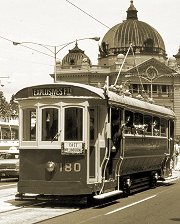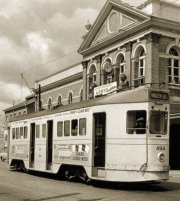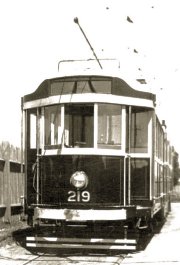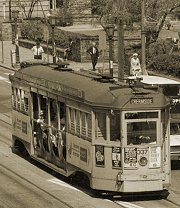Melbourne Tram Museum
- Follow Melbourne Tram Museum on Twitter
- Follow Melbourne Tram Museum on Facebook
- Follow Melbourne Tram Museum on Instagram
- Follow Melbourne Tram Museum on Pinterest
- Follow Melbourne Tram Museum on Tumblr
- Subscribe to Melbourne Tram Museum's RSS feed
- Email Melbourne Tram Museum
Art deco influence on Australian tramcar design
The term Art Deco was coined in the 1960s to refer to the visual motifs that dominated the boom period of the Roaring Twenties and the bust of the Depression era Thirties. These motifs represented many things to many people – the style of the flapper girl, the luxury ocean liner, the skyscraper – culminating in the fantasy world of Hollywood.
This style was dominant in the architectural idiom of the time, and was a conscious rejection of the fussiness of pre-World War I Art Nouveau; embracing modernity in the form of mass production and functionality of design, whilst fusing it with traditional themes from the ancient cultures of Egypt, the Hellenic world, and pre-Columbian America, as well as influences from Asia and Africa. It was particularly adaptable to the nationalist sentiments of the era, as well as appealing strongly to the new middle classes. The style was immensely popular for Australian buildings built during the interwar period, particularly for cinemas and other major public and commercial buildings. Extant examples in Melbourne include the Rivoli and Astor cinemas at Camberwell and Windsor respectively, and the Manchester Unity Building in Swanston Street.
Many of the tramway-associated buildings constructed during the expansion of the Melbourne electric tramway system during the 1920s and 1930s are exemplary examples of Art Deco. These buildings, designed by the architect of the Melbourne & Metropolitan Tramways Board, Alan G. Monsborough, include the former headquarters building at 616 Little Collins Street. 'Other tramway buildings of the same era still in use for their original purpose are Carlton Control in Bouverie Street, and tram depots in Camberwell, Glenhuntly and Brunswick.
However, the influence of Art Deco was not restricted to architecture – it was pervasive throughout all aspects of society, and had a major impact on the design of contemporary Australian electric tramcars.
Amongst the oldest surviving Australian tramcars to show the influence of Art Deco design principles were the S and T single truck trams [1] built for the Melbourne, Brunswick & Coburg Tramways Trust (MBCTT) in 1916 and 1918 respectively. Designed by the Chief Engineer of the Trust, Struan Robertson, and built by Duncan & Fraser of Adelaide, they display a conscious rejection of earlier Australian tramcar design, particularly in the use of an arch roof in place of the traditional clerestory roof. The uncluttered lines of these tramcars, together with their simple, clean interiors, were an early example of the growing influence of Art Deco in industrial design. Together with the Adelaide ‘Desert Gold’ tramcars [2] built contemporaneously by Duncan & Fraser, these tramcars were so influential that only one subsequent Australian design, the Geelong ‘Pengelley’ cars of 1922-23, included a clerestory roof.
However, the use of arched window sashes and the voluptuous curved sides of the body betray a lingering attachment to the sinusoidal curves beloved of Art Nouveau, so the Adelaide and MBCTT tramcars can only be viewed as a transitional stage in the evolution of Australian tramcar design towards the Art Deco paradigm.
It was not until the appearance of four new bogie tramcar designs between 1921 and 1925 that an uncompromising commitment towards the use of Art Deco principles in Australian tramcar design was achieved; all rejected the complex curved sides of the MBCTT tramcars for daunting but functional slab sides well adapted for mass production techniques. The only concession to exterior decoration was the design of the fascias around the roof-mounted destination boxes: everything else was a slave to function.
 Sydney P class no 1630 under maintenance at Randwick Workshops.
Sydney P class no 1630 under maintenance at Randwick Workshops.- Photograph courtesy State Records NSW.
Three of these designs were ‘drop centre’ tramcars, a peculiarly Australasian design: the Brisbane ‘Drop-centre’ [3] (1925), Melbourne W class [4] (1923) and Adelaide F class [5] (1921) tramcars. The fourth was the ‘toastrack’ Sydney P class [6] (1921), particularly suited to the heavy passenger loadings encountered on the Harbour City tramways. The interiors of all these tramcars made sumptuous use of heavily varnished timber, reflecting the interest in highly finished natural materials typical of the period.
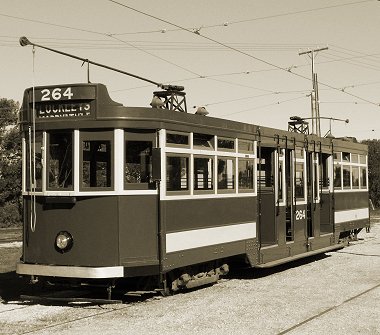 Adelaide F1 class no 264 at the Australian Electric Traction Museum
in St Kilda, South Australia, 2004.
Adelaide F1 class no 264 at the Australian Electric Traction Museum
in St Kilda, South Australia, 2004.- Photograph courtesy Mal Rowe.
The onset of the 1930s saw the development of Art Deco into a form known as Streamline Moderne. Heavily influenced by both the automotive and aviation industries, it had an obsession with expressing speed by use of streamlining. Everything material in society had to follow this new idiom of smooth flowing lines: motor cars such as the Chrysler Airflow and the Cord 810; passenger trains like the luxury air conditioned ‘Spirit of Progress’ built by Victorian Railways; and mass consumer goods including refrigerators, toasters and Bakelite radios.
The use of streamlining in all things expressed the ultimate in modernity; speed was everything. This was typified by the public interest in the setting of aviation long-distance speed records by such pioneers as Bert Hinkler and Charles Kingsford-Smith, culminating in the 1934 MacRobertson London to Melbourne Air Race, generating huge crowds only experienced nowadays at major sporting events.
Naturally, this obsession with speed was carried into the design of the humble tramcar. The first Australian tramcar to show the impact of Streamline Moderne was the Sydney R class tramcar [7] of 1933, a bogie drop centre design. This was exemplified by the introduction of a pointed nose at each end of the tramcar, replacing the former narrow driver’s cabs with cabs integrated into the body design. Square window frames were now softened by curved corners. However, the interior design was to remain consistent with what had gone before.
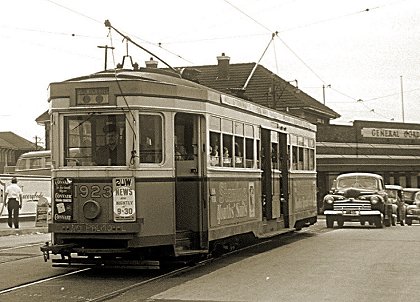 Sydney
R class no 1923 at Sydenham, 20 November 1954.
Sydney
R class no 1923 at Sydenham, 20 November 1954.- Photograph courtesy Noel Reed.
It was not until the development of the Sydney R1 [8] and Melbourne SW6 [9] ‘drop centre’ tramcars in 1936 and 1939 respectively that the full impact of Streamline Moderne was felt in the design of tramcar interiors in Australia’s two largest cities. Both tramcars featured the removal of internal timber bulkheads, and their replacement with glass semi-bulkheads. Fittings that had previously been timber or cast brass were now made from the new materials of stainless and chromium-plated steel; varnished timber was replaced by the new high-gloss paints; humble leather strap hangers were now Bakelite; window sash frames were no longer timber but metal; and hard wooden seats were replaced by luxurious leather upholstery.
-
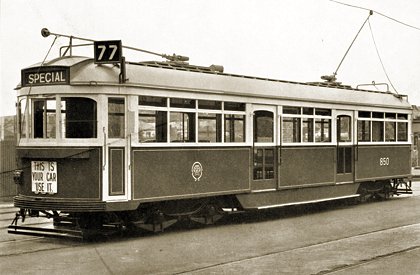 Builder’s
photograph of M&MTB SW6 class leader No 850, 1939.
Builder’s
photograph of M&MTB SW6 class leader No 850, 1939. - M&MTB photograph.
Instead of being dominated by gloomy varnished timbers, the interiors were now light, airy and spacious, meeting the demands of passengers for a level of comfort comparable to that experienced in the ever-more prevalent motor car. This design premise was so successful that the Sydney R1 class is thought by many to be the most attractive tramcar ever built in Australia, and a small number of largely unchanged SW6 class trams are still in service in Melbourne, albeit as ‘heritage’ tourist attractions.
-
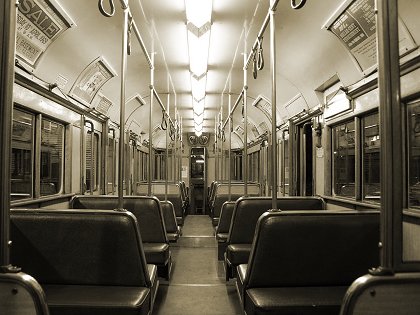 Interior
of Brisbane FM no 548 at Sydney Tramway Museum, showing the use of
stainless steel, glass and high gloss paints in Streamline Moderne
interior design.
Interior
of Brisbane FM no 548 at Sydney Tramway Museum, showing the use of
stainless steel, glass and high gloss paints in Streamline Moderne
interior design. - Photograph courtesy Mal Rowe.
The ultimate in Streamline Moderne and Art Deco tramcar design seen in Australia has to be the Brisbane FM class [10] of 1938. Its stark, streamlined exterior matched by the simple but comfortable interior perfectly expressed the obsessions of the period with speed and functionality. Heavy use of automotive motifs was made throughout the vehicle, even extending to the use of chromium-plated window winders, producing a tramcar of futuristic appearance that did not look out of place in traffic all the way up to the abandonment of Brisbane’s tramways in 1969.
 Builder’s photograph of Brisbane FM class no 536 just after completion
.
Builder’s photograph of Brisbane FM class no 536 just after completion
.- Photograph from the Melbourne Tram Museum collection.
The onset of World War II brought the Art Deco movement to a halt; its decorative and luxurious excesses were replaced by the realities of a wartime economy and the necessity for austerity. However, construction of Sydney R1, Brisbane FM and Melbourne SW6/W6/W7 tramcars continued until 1953, 1964 and 1956 respectively, ensuring ongoing use of Art Deco design principles well past their abandonment in other areas of endeavour. By the time the last of these tramcars was built, both Art Deco and electric tramcars were seen as symbols of a bygone era.
Only one more major Australian tramcar design followed the Art Deco aesthetic: the Adelaide H1 class tram [11] of 1951. Heavily influenced by the American PCC tramcar design of the 1930s and 1940s of which over five thousand were built, this solitary tramcar was to remain the only one of its kind, and would be retired from service in 1957; a victim of the replacement of trams by buses, just as Art Deco was replaced by post-war Modernism.
 Adelaide H1 no 381 at the Australian Electric Traction Museum at St
Kilda, South Australia, 2004.
Adelaide H1 no 381 at the Australian Electric Traction Museum at St
Kilda, South Australia, 2004.- Photograph courtesy Mal Rowe.
Bibliography
Clark, H.R. and Keenan D.R. (1977) Brisbane Tramways: The Last Decade, Transit Press
Cross, N., Budd, D., and Wilson, R. (1993) Destination City (Fifth Edition), Transit Australia Publishing
Fersin, M. and Nilsson, M. (2001) Art Deco in Australia – Sunrise over the Pacific, Craftsman House
Jones, R. (2007) Penny fare to Pentridge: a history of the Melbourne, Brunswick & Coburg Tramways Trust, Melbourne Tram Museum
Kings, K.S. (1966) ‘A Short History of the Geelong Tramways’, Running Journal April 1966, Tramway Museum Society of Victoria
M&MTB Annual Reports (1920-82)
MacCowan, I. A. (1990) The Tramways of New South Wales, Ian MacCowan
Wheaton, R.T. (1975) Destination Paradise, Australian Electric Traction Association
Wood, G., et al (2008) Art Deco 1910-1939, National Gallery of Victoria
Footnotes
[1] Melbourne S class 164 and T class 180 are on display at Hawthorn Depot, Victoria, on loan from the Tramway Museum Society of Victoria. A total of 18 and 6 cars respectively were built to each design.
[2] Adelaide ‘Desert Gold’ C class 186 is on display at the Australian Electric Traction Museum at St Kilda, South Australia. Twenty cars were built to this design.
[3] Brisbane ‘Drop-centre’ 231 is on display at the Brisbane Tramway Museum at Ferny Grove, Queensland. A total of 191 tramcars of this design were built.
[4] Melbourne W class 380 is on display at Hawthorn Depot, Victoria. A total of 410 tramcars were built to the closely related W/W1/W2 designs. Many examples of W2 class tramcars have been preserved in other Australian and New Zealand tramway museums.
[5] Adelaide F1 class 264 and 282 are on display at the Australian Electric Traction Museum at St Kilda, South Australia. A total of 84 tramcars were built to the closely related F/F1 designs.
[6] Sydney P class 1497 is on display at the Sydney Tram Museum at Loftus, New South Wales, with 250 examples of this design being built.
[7] Sydney R class 1740 is on display at the Sydney Tram Museum at Loftus, New South Wales. A total of 195 tramcars were built to this design.
[8] Multiple examples of Sydney R1 class trams are on display at the Sydney Tram Museum at Loftus, New South Wales. A total of 155 tramcars were built to this design.
[9] A total of 191 tramcars were built by the M&MTB to the closely related SW6/W6/Melbourne PCC/W7 designs, and an additional 3 ‘luxury’ cars were built to the same basic design by Victorian Railways. Multiple examples of Melbourne SW6/W6/W7 class trams are still operated by Yarra Trams on the City Circle and other ‘heritage’ routes, and W7 class tram 1040, the last W type tramcar built, is on display at Hawthorn Depot, Victoria. Similar trams of the same classes are preserved in other Australian and New Zealand tramway museums.
[10] A total of 155 Brisbane FM class tramcars were built by the Brisbane City Council. FM cars 400 and 554 are on display at the Brisbane Tramway Museum at Ferny Creek, Queensland.
[11] The solitary Adelaide H1 class tramcar, number 381, is on display at the Australian Electric Traction Museum at St Kilda, South Australia.
